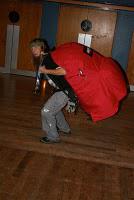I’m 2 weeks out from the Great North Walk 100 mile ultra event, the final race information has been sent out, and I’m starting to taper. It’s that time when I have to start thinking seriously about what lays ahead and preparing myself so that I am best equipped to reach my goals.
Any race plan will hinge on your goals for the race. For most of us the main goal for an ultramarathon is to finish. There are only a privileged few who have a specific target time in mind, and even those who have the experience know that finishing is more important than chasing a time only to record a DNF.
So with the goal to finish in mind, your preparation should be about avoiding those potential stumbling blocks along the way to the finish line.
 If it’s a course you haven’t run before take some time to familiarise yourself with the layout, especially any sections where you could get lost, and make note of the location of the checkpoints and the distances between them. This will help you mentally prepare for the run, and give you more confidence of the task ahead. Knowing that the next checkpoint is only 15km ahead can be a great lift, and knowing that you have a long hike to the next can enable you to prepare with the right amount of fluids, foods, clothing, etc.
If it’s a course you haven’t run before take some time to familiarise yourself with the layout, especially any sections where you could get lost, and make note of the location of the checkpoints and the distances between them. This will help you mentally prepare for the run, and give you more confidence of the task ahead. Knowing that the next checkpoint is only 15km ahead can be a great lift, and knowing that you have a long hike to the next can enable you to prepare with the right amount of fluids, foods, clothing, etc.You will want to be considering the conditions on the day, including the weather and ground conditions. Obviously you can’t know exactly what to expect, but the closer to race day you get the more accurate your expectations will be. The variation in conditions will have a major impact in two areas – the clothing you wear and the fuel, fluids and electrolytes you will consume. What you take with you for your race will be based upon your own knowledge of how your body performs under different conditions that you will have experienced in training (this is where a good training log will start paying you back).
 I like to take everything with me to the race to cover all eventualities and then fine tune what I carry when running on the day. Just don’t get drawn into taking something along just because you have the space in your pack – that’s something you learn the hard (heavy) way. You can be better off knowing that what you need is at the next checkpoint or with your crew.
I like to take everything with me to the race to cover all eventualities and then fine tune what I carry when running on the day. Just don’t get drawn into taking something along just because you have the space in your pack – that’s something you learn the hard (heavy) way. You can be better off knowing that what you need is at the next checkpoint or with your crew.If you have a crew it’s your responsibility to prepare them for the race too. You don’t want them getting lost or arriving late at a checkpoint – the negative mental effect you (and them) can be severe. Try and give them as much information as possible, especially expected timing (the splits from a previous year is ideal), and any mandatory gear that you have to carry from specific checks such as torches for night sections. Another great morale booster you can get from could be particular foods you like to have, or perhaps ice in your drink bottle, or even a kick up the arse – remember you will be tired and may not remember what you want and more importantly what you need. They are an important part of the team and the more they understand about your running habits, strengths and weaknesses the more they can contribute to the team success.

If you are running without a crew then more planning is essential. You will need to prepare your drop bags very carefully to cover the unexpected. In addition, familiarity with what is on offer at each checkpoint will facilitate better planning of what you need to prepare for yourself. You may even want to slip a motivational note or picture into your drop bag to give you that emotional lift (or kick!) that you need.
This highlights the major benefit of planning for your race. By mentally preparing for a race you will be in a better frame of mind to cope with the unexpected on race day. By planning weeks in advance of your race you are actually letting your subconscious know that it needs to prepare your body for what is ahead, so that you can mentally as well as physically peak on the day. By the same token, it will keep you focused on the goal and keep any problems in perspective. By way of example, you could bonk in a race and drop out, when taking an hour out to eat and rest could be sufficient to get you back on track and to reach your goal.
How I like to prepare for a race is by running the race in my head, visualising what will happen, what can go wrong, what I need to do at each checkpoint and so on. Visualising things going wrong and then overcoming them is a great way to prepare for such occasions as your brain can’t distinguish between what is imagined and what is reality. When you have done this and the problem occurs in reality you are far better prepared to overcome it.
The one thing I do visualise is crossing the finish line and the feelings that come with it. No matter how I visualise it the actual feeling is way beyond comparison.
Happy Running!
Andy
“90% of Ultrarunning is 100% mental” - Unknown, but I like it :-)
Training 28-10-2010 (48kms along the beach)
www.ultrarunning.com.au

